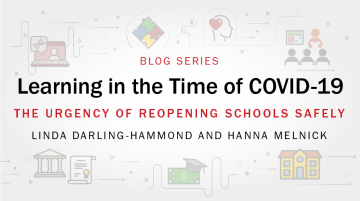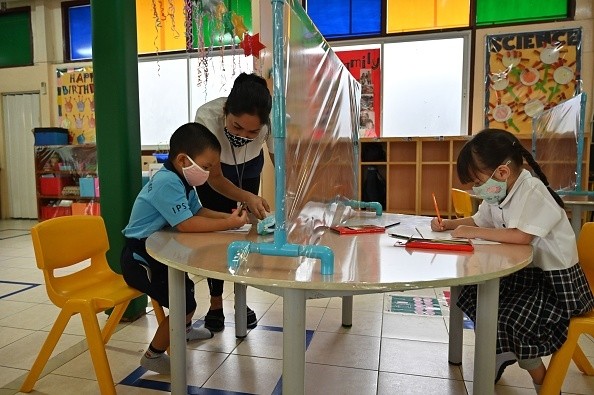The Urgency Of Reopening Schools Safely

This post was originally published on July 21, 2020 by Forbes, and is part of LPI's Learning in the Time of COVID-19 blog series, which explores evidence-based and equity-focused strategies and investments to address the current crisis and build long-term systems capacity.

Recently, President Trump tweeted, "In Germany, Denmark, Norway, Sweden and many other countries, SCHOOLS ARE OPEN WITH NO PROBLEMS…. May cut off funding if not open!"
What he should have tweeted was: “In a few countries with low infection rates, schools are open with major changes in how they operate.”
And his next tweet should have said: “We must immediately pass and fund the Heroes Act, including at least $200 billion in funding for education, so that U.S. schools can open safely.”
While it is true that some countries have reopened their schools, they did so in a different context than ours and with much more government support. Current U.S. infection rates are 100 times greater than those in Norway and Denmark and more than 500% greater than rates in Germany, Sweden, and other jurisdictions like Singapore, the Republic of Korea, Taiwan, and Hong Kong that have stayed open or reopened carefully, often partially and in stages. They also implemented important changes in how they operate schools.
Those changes incur costs that governments have supported to ensure health and safety, including:
- Testing and tracking of cases and quarantining those who exhibit symptoms or have been exposed to someone who has tested positive.
- Health checks for all students and staff every day—which require thermometers and staff to conduct checks and follow up when symptoms are reported.
- Physical distancing, which requires fewer students in each classroom and on each bus, along with additional staffing for more classrooms and bus runs.
- Mandatory face coverings, requiring investments in masks and face shields.
- Enhanced hygiene and cleaning, which often requires installing more sinks and hand-washing stations as well as purchasing sanitizers for all classrooms and hiring more custodial staff to disinfect more frequently.
- Technology and internet access to close the digital divide so that students who need to be home (because of health considerations or temporary quarantining or social distancing solutions) are able to fully participate in learning.
Countries that have reopened schools successfully have provided schools with these resources and others so that they can continue education and keep children and staff safe. Importantly, they have reopened only when infection rates are under control and have re-closed schools when rates have surged. Many began by opening elementary schools only, while high school students remained in distance learning, and have gradually added more grade levels.
Where these reopenings have succeeded, governments have been responsive to financial needs. Many countries have underwritten the costs of sanitation, masks, additional sinks, and hygienic facilities in schools. In addition to supporting staffing and providing supplies and equipment, Germany and the Republic of Korea have invested in computers and connectivity for all students to enable distance learning for those still learning from home. Germany also added money to extend the length of the school day. Denmark has offered community parks and buildings to provide space for physically distanced learning.
Where these investments and careful openings have not occurred, schools have had to close down again. Israel, for example, started with a slow reopening in early May when the virus was under control. But officials bowed to pressure to speed up the reopening. On May 17, all students went back to school with 30 to 40 pupils per class in close quarters. They were initially required to wear masks, but that requirement was dropped due to the heat. Within 2 weeks, several schools had outbreaks, including Gymnasium Rehavia in Jerusalem, where 130 students and staff were infected. In schools across the country, infections among children increased steadily after the full and hasty reopening. In late May, Israel’s public health director quit in protest, saying the country had “lost its bearings” in handling the pandemic. By mid-June, 355 schools had closed again, along with many other parts of the country.
South Africa also began with a staged approach to reopening schools in early June, bringing students in grades 7 and 12 back to campus. But it, too, pushed to reopen quickly—and with high school students, who, some studies suggest, are likely to experience much higher infection rates than young children. Although there were no reported confirmed cases when South African schools closed at the beginning of March, by early July, after one month of school, more than 1,260 students and 2,400 teachers tested positive for Covid-19, and 968 schools were closed again because of outbreaks. As parents and teachers have expressed growing concern, the future of reopening is unclear.
The outbreaks that caused a number of French schools to close a week after opening were also in high schools. Medical researchers found that in one high school, more than one third of students, and about half of staff were infected. And in early July, a teen summer camp in Missouri had to close, having experienced 82 cases of Covid-19 in less than one month.
Opening schools willy nilly as Trump advocates—in communities with high infection rates and without face coverings, smaller classes that allow physical distancing, adequate testing, and intensive hygiene and cleaning—will surely backfire. Yet with close to $2.8 trillion in federal aid devoted to the recovery thus far, only $13 billion has been allocated specifically to k–12 education. That’s less than half of one percent of the total funding. That is, on average, $286 per student—nowhere near what is needed to enable a safe return to school.
Meeting these challenges requires federal support. Recent estimates put state revenue shortfalls at 10% in the fiscal year that just ended, with an expectation that they will rise to about 25% in the new fiscal year. On top of this, states are facing additional health care, unemployment, and education-related costs. Because states cannot engage in deficit spending, substantial education cuts are inevitable without federal assistance. Even conservative estimates of state funding cuts to schools suggest that states will need between $200 and $300 billion to stabilize their k–12 education budgets and meet even a portion of the additional costs over the next year and a half.
The absence of meaningful federal support also has significant equity implications. We know that communities of color and those with concentrated poverty are most impacted by Covid-19, and schools in these communities have fewer resources to respond to this crisis. Prior to the pandemic, there was already a deep spending gap—with districts that serve the largest populations of Black, Latino/a, and Native American students operating with 13% less funding—or about $1,800 per student less per year—than those with the fewest students of color.
Declines in state revenue and increased costs will disproportionately hit schools in low-wealth/high-poverty communities that rely more on education funding from state sales and income taxes than on the more stable local property taxes that benefit schools in higher-income districts. As state revenue decreases and education costs increase, this funding gap will also grow.
The $300 billion needed to stabilize school funding and fully cover the additional costs of opening schools safely would be a tiny portion of the recovery aid Congress has provided businesses and governments, but it will be hugely important for children and their families: According to the American Association of Pediatrics, “There is already evidence of the negative impacts on children because of school closures in the spring of 2020” that range from abuse to food insecurity to depression and learning loss. At the same time, the Academy has also made it clear that schools should open only in communities where infection rates are under control. States like New York and California that are setting community health standards for school re-opening, as well as clear ground rules for how they reopen, are demonstrating a safe and responsible way forward.
In these unprecedented times, only one thing has remained consistent—disruption. It is heart-breaking to see the educational disruption an entire generation of students is enduring, and we must prioritize resuming and improving educational opportunities with safety and security. Rather than decide one of the most critical policies of our times with a tweet, we would do well to look carefully at what has worked—and what has not worked—around the world, so that we can put in place plans that can succeed. These plans require adequate funding to ensure U.S. students can get back to the critical business of learning while businesses get back to the critical business of opening—safely.
